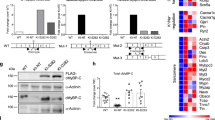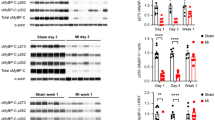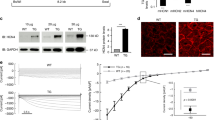Abstract
The myofilament protein troponin I (TnI) has a key isoform-dependent role in the development of contractile failure during acidosis and ischemia. Here we show that cardiac performance in vitro and in vivo is enhanced when a single histidine residue present in the fetal cardiac TnI isoform is substituted into the adult cardiac TnI isoform at codon 164. The most marked effects are observed under the acute challenges of acidosis, hypoxia, ischemia and ischemia-reperfusion, in chronic heart failure in transgenic mice and in myocytes from failing human hearts. In the isolated heart, histidine-modified TnI improves systolic and diastolic function and mitigates reperfusion-associated ventricular arrhythmias. Cardiac performance is markedly enhanced in transgenic hearts during reperfusion despite a high-energy phosphate content similar to that in nontransgenic hearts, providing evidence for greater energetic economy. This pH-sensitive 'histidine button' engineered in TnI produces a titratable molecular switch that 'senses' changes in the intracellular milieu of the cardiac myocyte and responds by preferentially augmenting acute and long-term function under pathophysiological conditions. Myofilament-based inotropy may represent a therapeutic avenue to improve myocardial performance in the ischemic and failing heart.
This is a preview of subscription content, access via your institution
Access options
Subscribe to this journal
Receive 12 print issues and online access
$209.00 per year
only $17.42 per issue
Buy this article
- Purchase on Springer Link
- Instant access to full article PDF
Prices may be subject to local taxes which are calculated during checkout





Similar content being viewed by others
References
Michaud, C.M., Murray, J.L. & Borton, A.R. Burden of disease—implications for future research. J. Am. Med. Assoc. 285, 535–539 (2001).
Steg, P.G. et al. Determinants and prognostic impact of heart failure complicating acute coronary syndromes: observations from the Global Registry of Acute Coronary Events (GRACE). Circulation 109, 494–499 (2004).
Deedwania, P.C. The key to unraveling the mystery of mortality in heart failure. Circulation 107, 1719–1721 (2003).
Lee, J.A. & Allen, D.G. Mechanisms of acute ischemic contractile failure of the heart: role of intracellular calcium. J. Clin. Invest. 88, 361–367 (1991).
Metzger, J.M. & Westfall, M.V. Covalent and noncovalent modification of thin filament action: the essential role of troponin in cardiac muscle regulation. Circ. Res. 94, 146–158 (2004).
Solaro, R.J., Lee, J.A., Kentish, J.C. & Allen, D.G. Effects of acidosis on ventricular muscle from adult and neonatal rats. Circ. Res. 63, 779–787 (1988).
Westfall, M.V., Rust, E.M. & Metzger, J.M. Slow skeletal troponin I gene transfer, expression, and myofilament incorporation enhances adult cardiac myocyte contractile function. Proc. Natl. Acad. Sci. USA 94, 5444–5449 (1997).
Westfall, M.V., Borton, A.R., Albayya, F. & Metzger, J.M. Specific charge differences in troponin I isoforms influence myofilament calcium sensitivity of tension in adult cardiac myocytes. Biophys. J. 80, 356A (2001).
Dargis, R., Pearlstone, J.R., Barrette-Ng, I., Edwards, H. & Smillie, L.B. Single mutation (A162H) in human cardiac troponin I corrects acid pH sensitivity of Ca2+-regulated actomyosin S1 ATPase. J. Biol. Chem. 277, 34662–34665 (2002).
Westfall, M.V., Albayya, F.P., Turner, I.I. & Metzger, J.M. Chimera analysis of troponin I domains that influence Ca2+-activated myofilament tension in adult cardiac myocytes. Circ. Res. 86, 470–477 (2000).
Robbins, J. Remodeling the cardiac sarcomere using transgenesis. Annu. Rev. Physiol. 62, 261–287 (2000).
Michele, D.E., Gomez, C.A., Hong, K.E., Westfall, M.V. & Metzger, J.M. Cardiac dysfunction in hypertrophic cardiomyopathy mutant tropomyosin mice is transgene-dependent, hypertrophy-independent, and improved by β-blockade. Circ. Res. 92, 255–262 (2002).
Fentzke, R.C. et al. Impaired cardiomyocyte relaxation and diastolic function in transgenic mice expressing slow skeletal troponin I in the heart. J. Physiol. (Lond.) 517, 143–157 (1999).
Westfall, M.V., Turner, I.I., Albayya, F.P. & Metzger, J.M. Troponin I chimera analysis of the cardiac myofilament tension response to protein kinase A. Am. J. Physiol. 280, C324–C332 (2001).
Jain, M. et al. Increased myocardial dysfunction after ischemia-reperfusion in mice lacking glucose-6-phosphate dehydrogenase. Circulation 109, 898–903 (2004).
Dewald, O. et al. Development of murine ischemic cardiomyopathy is associated with a transient inflammatory reaction and depends on reactive oxygen species. Proc. Natl. Acad. Sci. USA 100, 2700–2705 (2003).
Sakamoto, J. et al. Reperfusion arrhythmias in the murine heart: their characteristics and alteration after ischemic preconditioning. Basic Res. Cardiol. 94, 489–495 (1999).
del Monte, F. et al. Abrogation of ventricular arrhythmias in a model of ischemia and reperfusion by targeting myocardial calcium cycling. Proc. Natl. Acad. Sci. USA 101, 5622–5627 (2004).
Wainwright, C.L., Miller, A.M., Work, L.M. & Del Soldato, P. NCX4016 (NO-aspirin) reduces infarct size and suppresses arrhythmias following myocardial ischaemia/reperfusion in pigs. Br. J. Pharmacol. 135, 1882–1888 (2002).
Naito, H., Furukawa, Y., Chino, D., Yamada, C. & Hashimoto, K. Effects of zatebradine and propranolol on canine ischemia and reperfusion-induced arrhythmias. Eur. J. Pharmacol. 388, 171–176 (2000).
Piper, H.M., Meuter, K. & Schafer, C. Cellular mechanisms of ischemia-reperfusion injury. Ann. Thorac. Surg. 75, S644–S648 (2003).
Gould, K. et al. Heart failure and greater infarct expansion in middle-aged mice: a relevant model for postinfarction failure. Am. J. Physiol. 282, H615–H621 (2002).
Westfall, M.V., Rust, E.M., Albayya, F. & Metzger, J.M. Adenovirus-mediated myofilament gene transfer into adult cardiac myocytes. Methods Cell Biol. 52, 307–322 (1997).
del Monte, F. et al. Restoration of contractile function in isolated cardiomyocytes from failing human hearts by gene transfer of SERCA2a. Circulation 100, 2308–2311 (1999).
Rossman, E.I. et al. Abnormal frequency-dependent responses represent the pathophysiologic signature of contractile failure in human myocardium. J. Mol. Cell. Cardiol. 36, 33–42 (2004).
Takeda, S., Yamashita, A., Maeda, K. & Maeda, Y. Structure of the core domain of human cardiac troponin in the Ca (2+)-saturated form. Nature 424, 35–41 (2003).
Perutz, M.F., Gronenborn, A.M., Clore, G.M., Fogg, J.H. & Shih, D.T. The pKa values of two histidine residues in human haemoglobin, the Bohr effect, and the dipole moments of α-helices. J. Mol. Biol. 183, 491–498 (1985).
Rotzschke, O., Lau, J.M., Hofstatter, M., Falk, K. & Strominger, J.L. A pH-sensitive histidine residue as control element for ligand release from HLA-DR molecules. Proc. Natl. Acad. Sci. USA 99, 16946–16950 (2002).
Zong, X., Stieber, J., Ludwig, A., Hofmann, F. & Biel, M. A single histidine residue determines the pH sensitivity of the pacemaker channel HCN2. J. Biol. Chem. 276, 6313–6319 (2001).
Cave, A.C. et al. ATP synthesis during low flow ischemia: influence of increased glycolytic substrate. Circulation 101, 2090–2096 (2000).
Cross, H.R., Kranias, E.G., Murphy, E. & Steenbergen, C. Ablation of PLB exacerbates ischemic injury to a lesser extent in female and male mice: protective role of NO. Am. J. Physiol. 284, H683–H690 (2002).
Cross, H.R., Lu, L., Steenbergen, C., Philipson, K.D. & Murphy, E. Overexpression of the cardiac Na+/Ca2+ exchanger increases susceptilibility to ischemia/reperfusion injury in male, but not female, transgenic mice. Circ. Res. 83, 1215–1223 (1998).
Mulieri, L.A., Hasenfuss, G., Leavitt, B., Allen, P. & Alpert, N.R. Altered myocardial force-frequency relation in human heart failure. Circulation 85, 1743–1750 (1992).
Hasenfuss, G. et al. Relation between myocardial function and expression of sarcoplasmic reticulum Ca2+-ATPase in failing and nonfailing human myocardium. Circ. Res. 75, 434–442 (1994).
Pieske, B., Maier, L.S., Bers, D.M. & Hasenfuss, G. Ca2+ handling and sarcoplasmic reticulum Ca2+ content in isolated failing and nonfailing human myocardium. Circ. Res. 85, 38–46 (1999).
del Monte, F., Harding, S.E., Dec, G.W., Gwathmey, J.K. & Hajjar, R.J. Targeting phospholamban by gene transfer in human heart failure. Circulation 105, 904–907 (2002).
Chaudhary, K.W. et al. Altered myocardial Ca2+ cycling after left ventricular assist device support in the failing human heart. J. Am. Coll. Cardiol. 44, 837–845 (2004).
Heerdt, P.M. et al. Chronic unloading by left ventricular assist device reverses contractile dysfunction and alters gene expression in end-stage heart failure. Circulation 102, 2713–2719 (2000).
Murphy, A.M. et al. Transgenic mouse model of stunned myocardium. Science 287, 488–491 (2000).
Kimura, A. et al. Mutations in the cardiac troponin I gene associated with hypertrophic cardiomyopathy. Nat. Genet. 16, 379–382 (1997).
Mogensen, J. et al. Idiopathic restrictive cardiomyopathy is part of the clinical expression of cardiac troponin I mutations. J. Clin. Invest. 111, 209–216 (2003).
Westfall, M.V., Borton, A.R., Albayya, F.P. & Metzger, J.M. Myofilament calcium sensitivity and cardiac disease: insights from troponin I isoforms and mutants. Circ. Res. 91, 525–531 (2002).
Spindler, M. et al. Diastolic dysfunction and altered energetics in the α-MHC 403/+ mouse model of familial hypertrophic cardiomyopathy. J. Clin. Invest. 101, 1775–1783 (1998).
Javadpour, M.M., Tardiff, J.C., Pinz, I. & Ingwall, J.S. Decreased energetics in murine hearts bearing the R92Q mutation in cardiac troponin T. J. Clin. Invest. 112, 768–775 (2003).
Michele, D.E., Albayya, F. & Metzger, J.M. Thin filament protein dynamics in fully differentiated adult cardiac myocytes: toward a model of sarcomere maintenance. J. Cell Biol. 145, 1483–1495 (1999).
Coutu, P., Bennett, C.N., Favre, E.G., Day, S.M. & Metzger, J.M. Parvalbumin corrects slowed relaxation in adult cardiac myocytes expressing hypertrophic cardiomyopathy-linked α-tropomyosin mutations. Circ. Res. 94, 1235–1241 (2004).
Saupe, K.W., Spindler, M., Tian, R. & Ingwall, J.S. Impaired cardiac energetics in mice lacking muscle-specific isoenzymes of creatine kinase. Circ. Res. 82, 898–907 (1998).
Szatkowski, M.L. et al. In vivo acceleration of heart relaxation performance by Parvalbumin gene delivery. J. Clin. Invest. 107, 191–198 (2001).
Mundina-Weilenmann, C., Vittone, L., Cingolani, H.E. & Orchard, C.H. Effects of acidosis on phosphorylation of phospholamban and troponin I in rat cardiac muscle. Am. J. Physiol. 39, C107–C114 (1996).
Tarnavski, O. et al. Mouse cardiac surgery: comprehensive techniques for the generation of mouse models of human diseases and their application for genomic studies. Physiol. Genomics 16, 349–360 (2004).
Acknowledgements
We thank J. Li, A. Lopatin, S. Whitesall, R. Liao, K. Converso, M. Russell, F. Pagani, H. Patel, E. DeVaney, D. Dyke, E. Favre, A. Sober-Rankin, K. Pasyk and S. Forfa for assistance and expertise. This work was supported by grants from the American Heart Association (0475032N to S.M.D.) and the US National Institutes of Health (HL67254 to M.V.W., HL52320 and HL63985 to J.S.I., and HL059301 to J.M.M.).
Author information
Authors and Affiliations
Corresponding author
Ethics declarations
Competing interests
The authors declare no competing financial interests.
Supplementary information
Supplementary Fig. 1
Representative tension-pCa relationships in adult single cardiac myocytes expressing cTnI (control), ssTnI or ssTnI H132A. (PDF 770 kb)
Supplementary Fig. 2
Summary of pCa50 in cardiac myocytes after cTnI A164H adenoviral gene transfer in isolated rat cardiac myocytes. (PDF 25 kb)
Supplementary Fig. 3
Confocal imaging of indirect immunofluorescently labeled myocardial cryosections. (PDF 386 kb)
Supplementary Fig. 4
Cell and organ morphometrics, histology and electron microscopy. (PDF 145 kb)
Supplementary Fig. 5
Protein expression in intact hearts. (PDF 54 kb)
Supplementary Fig. 6
Isolated myocyte and heart organ responses to β-adrenergic stimuli. (PDF 605 kb)
Supplementary Fig. 7
Intraventricular pressures during ischemia and reperfusion in isolated mouse hearts from two independent transgenic mouse lines. (PDF 40 kb)
Supplementary Fig. 8
Effects of ischemia and reperfusion in cTnI A164H mice in vivo. (PDF 25 kb)
Supplementary Table 1
Energetic enzyme measurements. (PDF 10 kb)
Rights and permissions
About this article
Cite this article
Day, S., Westfall, M., Fomicheva, E. et al. Histidine button engineered into cardiac troponin I protects the ischemic and failing heart. Nat Med 12, 181–189 (2006). https://doi.org/10.1038/nm1346
Received:
Accepted:
Published:
Issue Date:
DOI: https://doi.org/10.1038/nm1346
This article is cited by
-
Lipids: a Potential Molecular Pathway Towards Diastolic Dysfunction in Youth-Onset Type 2 Diabetes
Current Atherosclerosis Reports (2022)
-
Cardiac 31P MR spectroscopy: development of the past five decades and future vision—will it be of diagnostic use in clinics?
Heart Failure Reviews (2022)
-
Genetic, clinical, molecular, and pathogenic aspects of the South Asian–specific polymorphic MYBPC3Δ25bp variant
Biophysical Reviews (2020)
-
Targeting the sarcomere to correct muscle function
Nature Reviews Drug Discovery (2015)
-
Reconstitution of coronary vasculature by an active fraction of Geum japonicum in ischemic hearts
Scientific Reports (2014)



